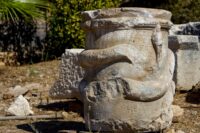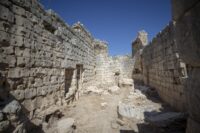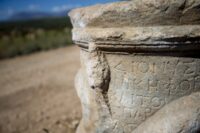 A cylindrical altar carved with the figure of a snake winding around it has been discovered at the archaeological site of Patara in southwestern Turkey’s Antalya district. Archaeologists unearthed the altar in an excavation of the Roman-era public baths near the ancient city walls. The marble altar was originally associated with a tomb and would have been used to leave offerings of food or drink to the gods for the benefit of the deceased. Its find site at the baths, built under Nero in the 60s A.D., and the style of the carving dates it to the Roman era, about 2,000 years ago.
A cylindrical altar carved with the figure of a snake winding around it has been discovered at the archaeological site of Patara in southwestern Turkey’s Antalya district. Archaeologists unearthed the altar in an excavation of the Roman-era public baths near the ancient city walls. The marble altar was originally associated with a tomb and would have been used to leave offerings of food or drink to the gods for the benefit of the deceased. Its find site at the baths, built under Nero in the 60s A.D., and the style of the carving dates it to the Roman era, about 2,000 years ago.
(Fun fact: the dedicatory inscription found on one of the doorways between the frigidarium and the tepidarium gives all credit for the construction of the baths to Vespasian. The surviving parts read: “The bath was built from scratch by the ultimate ruler, sacred Flavius Vespasianus… during the time of military governor Sextus Marcus Priscus by using the security funds collected from the people and with contributions of the military unit with all of the ornaments and decorations and swimming pool.”
Epigraphers discovered that the initial lines of the inscription were scraped off and Vespasian’s name engraved over the erasure. The long arm of the Roman senate’s damnatio memoriae of Nero, perhaps? Or maybe just a courtesy carve-out to pretend the emperor who repaired the bath and the aqueduct that supplied it was the one who built it. The “from scratch” bit does seem a little heavy-handed.)
 Located on the Mediterranean coast of southwestern Lycia, the Hellenistic city was founded in the 8th century B.C. and prospered as a harbor city connecting trade from the Mediterranean to the interior via the Xanthus River which flowed through the city in antiquity. Patara, which according to the legend was founded by Apollo’s son Patarus, was renown for its Temple of Apollo and oracle. The former was second in importance only to the temple at Delos; the latter only to the oracle at Delphi. Apollo himself was said to live there, summering at Delos but enjoying the fine winter climate at Patara. Because of this, ancient chroniclers claim, the priestess only worked the oracle at Patara in the winter.
Located on the Mediterranean coast of southwestern Lycia, the Hellenistic city was founded in the 8th century B.C. and prospered as a harbor city connecting trade from the Mediterranean to the interior via the Xanthus River which flowed through the city in antiquity. Patara, which according to the legend was founded by Apollo’s son Patarus, was renown for its Temple of Apollo and oracle. The former was second in importance only to the temple at Delos; the latter only to the oracle at Delphi. Apollo himself was said to live there, summering at Delos but enjoying the fine winter climate at Patara. Because of this, ancient chroniclers claim, the priestess only worked the oracle at Patara in the winter.
Snakes are central to the mythology of Apollo, particular to his oracles. Apollo slew the Python, the underworld deity who relayed messages from his mother Gaia to petitioners at the Delphic oracle, and replaced him as the god of record in Delphi. Python’s priestesses kept their jobs under the new administration, and the main priestess of the oracle at Delphi was thereafter called the Pythia.
 The remains of the famous Temple of Apollo have yet to be discovered, but a large bust of the god unearthed just inside the city gate is believed to have adorned it. The city’s association with Apollo is also evident in its coinage. He appears on drachms from the 2nd century B.C. all the way through to imperial coinage of the emperor Gordian III in the 3rd century. Several of the Gordian issues feature a serpent coiled around a tripod cauldron. One features Apollo standing inside his temple with a serpent-wrapped column to his right.
The remains of the famous Temple of Apollo have yet to be discovered, but a large bust of the god unearthed just inside the city gate is believed to have adorned it. The city’s association with Apollo is also evident in its coinage. He appears on drachms from the 2nd century B.C. all the way through to imperial coinage of the emperor Gordian III in the 3rd century. Several of the Gordian issues feature a serpent coiled around a tripod cauldron. One features Apollo standing inside his temple with a serpent-wrapped column to his right.
The altar will now be cleaned, conserved and studied and when the work is complete, it will be exhibited at the Demre Museum.